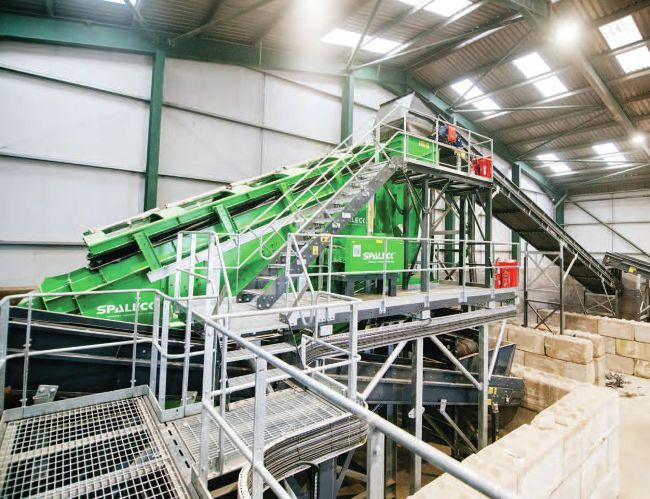SPECIAL FEATURE
A first in recycling
Why United Kingdom-based recycling specialist Collard Group chose a Terex Recycling Systems installation.

The plant was tailored to meet the requirements of the Collard site and the materials to be fed into it.
PHOTO: TEREX RECYCLING SYSTEMS
What they said
Rober t Collard, MD, Collard Group
This is one of the major things that we do outside of demolition. We have doubled the capacity of construction and demolition waste per hour.
We are doing this with 10 or 12 diffferent commodities – the commodity market is very strong and a crucial part of recycling – and we also handle a lot of waste from demolition, from the soft strip of buildings for instance.
We were one of the first people to win a construction industry award, but the old plant was getting tired and we did not have enough capacity. So we commissioned the new plant and it was all done in January and February during the quieter months.
Collard Group, a leader in recycling and waste management based inthe south of England, has chosen a Terex Recycling Systems plant to increase processing capacity at its site and recover cleaner, higher-value products, without adding to its manual labour requirements. Initially intending a plant upgrade, Collard opted for a full plant installation after seeing the first phase of the installation.
The plant, which is the first Terex Recycling Systems installation, was tailored to suit Collard Group’s site and the material to be fed into it.
Together with distributor Molson Green, Terex Recycling Systems developed a process which incorporated advanced mechanical separation.
RESTRICTED SPACE
The team worked within restricted space to fit the plant inside and around the existing building while planning the installation around Collard Group’s site works, including a new building.
Thomas McKiver, sales director of Molson Green said “We are delighted to have sold and installed Terex Recycling Systems’ first plant to the Collard Group. “This plant will help them achieve their desired targets of increasing processing capacity and to recover greater percentages of cleaner recycling products, thus diverting more material from landfill.”
The process starts with skip material being loaded into a waste feeder and conveyed to a combi screen, which separates into four size fractions using a combination of 3D and Flip-Flow screening (0 to 10 mm, 10 to 50 mm, 50 to 100 mm and over 100mm).
LIGHT MATERIAL
Over-band magnets recover ferrous metals from 0 to 10 mm, 10 to 50 mm and 50 to 100 mm, and air separators remove light material from 10 to 50 mm and 50 to 100 mm.
A manual quality control picking station has operators working to remove any remaining contaminants from the 10 to 100 mm heavy fraction.
Following this, an eddy current separator recovers non-ferrous metal from the 10 to 100 mm heavy fraction. Another manual picking station has operators recovering materials such as wood, card, and plastic from the +100 mm, and an over-band magnet recovers ferrous metal. Finally, an air separator removes light material from the +100mm.
“
We are driven by zero waste to landfill. We take waste from the site and process it to make it useful again. We call this recycling the past for the future”
SKIP WASTE
The plant handles skip waste – amixture of Commercial and Industrial (C&I) and Construction and Demolition (C&D) waste.
Robert Collard, managing director of Collard Group said: “We are driven by a zero waste to landfill commitment, we take waste from site, and process it to make it useful again.
“We call this recycling the past for the future.” ■

After originally favouring an upgrade, Collard Group opted for a full plant installation
What they said
Thomas McKiver, sales director, Molson Green We have dealt with Collard for a number of years on all Terex products. When Rob knew we were able to supply a recycling plant he asked us to quote for the Reading site.
We measured up what room he had for the plant, worked out the parameters, what tonnage he wanted to do, what products he wanted to pick.
We had the initial couple of meetings on Teams, then the project became a collaboration of our input and his inputs, after which we took out the old plant and put in the new one.
The plant is about diverting as much material from landfill as possible, and turning recycling into a resaleable product.